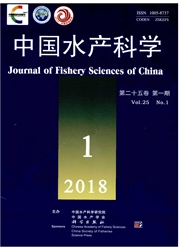

 中文摘要:
中文摘要:
鱼类目标强度(target strength)的测量是渔业声学技术研究和应用的核心内容之一。2015年6―10月,在小型水槽内使用Bio Sonics DT-X(199kHz)科学探鱼仪发射水平声波,测量了4种共29尾不同鳔室结构的淡水养殖鱼类体侧向及背腹向(180°范围)的目标强度,并拍摄X光影像以了解鱼体鳔室结构及特征。其中瓦氏黄颡鱼(Pelteobagrus vachelli)7尾、鳜鱼(Siniperca chuatsi)9尾、鲫鱼(Carassius auratus)6尾、草鱼(Ctenopharyngodon idellus)7尾。结果显示,单体鱼目标强度与声波入射角度具有cos三次方函数关系,体侧向与背腹向上最大目标强度均出现于鱼体主轴垂直于入射声波时,最小目标强度出现于头尾方向朝向声波时,与最大目标强度相差10dB。不同种鱼类体侧向平均目标强度略大于背腹向0.5~5dB。单室鳔鱼类目标强度比相近体长的两室鳔鱼类小。对4种鱼类的目标强度与鱼体相关生物学指标进行主成分分析,体侧向与背腹向目标强度主要受体长、鳔长和鳔长/鳔高值的影响较大。通过目标强度与实验鱼全长、体长、体重的线性回归,获得体侧和背腹入射方向目标强度与3个生物学参数的关系式。本研究通过分析不同鳔室形态鱼种的回波特征差异,辅助判别长江内常见鱼类(如瓦氏黄颡鱼、鱖鱼、鲫鱼等)的声学信号,结果对于淡水水域水平原位监测时分析评估资源量相关参数具有参考意义。
 英文摘要:
英文摘要:
Measuring fish target strength (TS) is the foundation of fisheries acoustic research and its applications. TS measurements focused on fish in the Yangtze River are lacking or do not meet the needs for a fisheries resource assessment. Variations in TS of four freshwater cultured fish species with different swim bladder structures were measured with a BioSonics DT-X (199 kHz) split beam echosounder in the horizontal direction. The four fish were Vachell's bagrid fish (Pelteobagrus vachelli), Mandarin fish (Siniperca chuatsi), crucian carp (Carassius auratus), and grass carp (Ctenopharyngodon idellus). An ex situ experiment was carried out in a small T-shaped tank during June and October 2015. The tank was constructed of eight fiberglass-reinforced plastic boards. Polyurethane foaming plastic cotton was pasted on the internal face of the tank to absorb any sounds reverberating from multiple echoes. Twenty-nine individuals were anaesthetized and tethered on a horizontal rotation support, in turn, and TS was measured at different horizontal angles. The angles were changed from -90° to 90° at an interval of 5°. Individual TS was measured for 300 pings at each angle. The results showed that mean TS of fish was affected by the aspect angle. Maximum TS occurred in the lateral direction, and minimum TS occurred in the head-tail direction. The difference between the maximum and minimum TS was about 10 dB. A cos functional relationship was observed between the measured TS and the sound wave incident angle, as well as from the fish dorsal-ventral direction. Fish TS values were smaller in the dorsal aspect than those in the side aspect. These differences may have been affected by the shape of the swim bladder and its position in the body. Two X-ray images were taken from the side and dorsal aspects of each fish to understand the inner structure of the fish and the swim bladder. TS of fish with a one-chambered swim bladder was smaller than that fish with a multi-chambered swim bladder, even though s
 同期刊论文项目
同期刊论文项目
 同项目期刊论文
同项目期刊论文
 期刊信息
期刊信息
